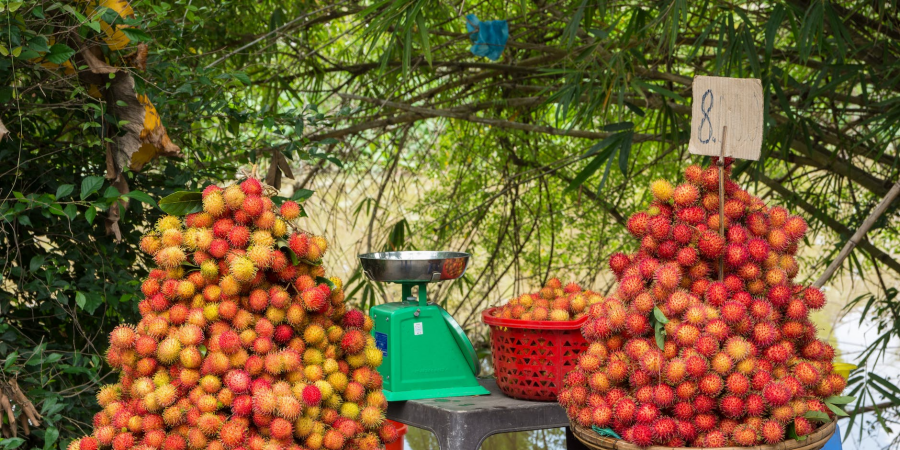

Rambutan
This article is about the tree.
Rambutan ( scientific classification: Nephelium lappaceum) is a medium-sized tropical tree in the family Sapindaceae. The name likewise alludes to the eatable organic product created by this tree. The rambutan is local to Southeast Asia. It is firmly connected with a few other palatable tropical natural products including the lychee, longan, pulasan and guinep.
Natural product
The natural product is a round to oval single-cultivated drupe, 3-6 cm (seldom to 8 cm) long and 3-4 cm expansive, borne in a free pendant group of 10-20 together. The rough skin is rosy (seldom orange or yellow) and covered with plump flexible spines, subsequently the name, and that signifies 'hairs'. The spines (otherwise called "spinterns") add to the happening of the natural product, which can influence the organic product's quality.
The natural product tissue, the aril, is clear, whitish or exceptionally pale pink, with a sweet, somewhat acidic flavor suggestive of grapes.
The single seed is polished brown, 1-1.3 cm, with a white basal scar. Delicate and containing equivalent segments of soaked and unsaturated fats, the seed might be cooked and eaten, yet is unpleasant and has opiate properties.: 14
Supplements
Rambutan natural product is 78% water, 21% sugars, 1% protein, and has irrelevant fat (table; information are for canned natural product in syrup; crude natural product information are unpublished). As far as dietary substance, the canned organic product contains just manganese at a moderate level (16% of the Everyday Worth), while giving 82 calories in a 100 gram reference sum (table). Different micronutrients are at a low level.
Culinary
The product of the rambutan tree might be eaten crude by eliminating the strip, eating the mash, and disposing of the seed. Rambutan is most frequently utilized in sweets, like sorbets and puddings, yet in addition in curries and flavorful dishes. The flavor is like lychee, and coordinates well with other tropical fruits.[citation needed]
Historical underpinnings
The name "rambutan" is gotten from the Malay word rambut signifying 'hair' alluding to the various bristly projections of the organic products, along with the thing building postfix - an. Additionally, in Vietnam, they are called chôm chôm (signifying ‘chaotic hair’)
Phytochemicals
As an unpigmented natural product tissue, rambutan doesn't contain critical polyphenol content, yet its vivid skin shows different phenolic acids, for example, syringic, coumaric, gallic, caffeic, and ellagic acids. Rambutan seeds contain equivalent extents of immersed and unsaturated fats, where arachidic (34%) and oleic (42%) acids, separately, are most noteworthy in fat substance.
The charming scent of rambutan natural product gets from various unstable natural mixtures, including beta-damascenone, vanillin, phenylacetic corrosive, and cinnamic corrosive.
History
Around the thirteenth to fifteenth hundreds of years, Middle Easterner brokers, who assumed a significant part in Indian Sea exchange, acquainted rambutans with Zanzibar and Pemba of East Africa. There are restricted rambutan plantings in certain pieces of India. In the nineteenth 100 years, the Dutch presented rambutans from Indonesia in Southeast Asia, to Suriname in South America. In this way, the plants spread to tropical Americas, established in the beach front marshes of Colombia, Ecuador, Honduras, Costa Rica, Trinidad and Cuba. In 1912, rambutans were acquainted with the Philippines from Indonesia. Further presentations were made in 1920 (from Indonesia) and 1930 (from Malaya), yet until the 1950s its dissemination was restricted.
There was an endeavor to acquaint rambutans with the Southeastern US, with seeds imported from Java, Indonesia in 1906, yet the species ended up being fruitless, besides in Puerto Rico.
